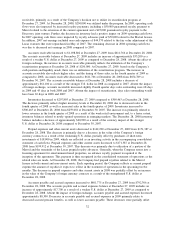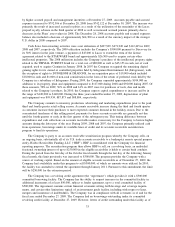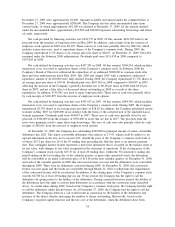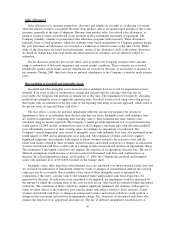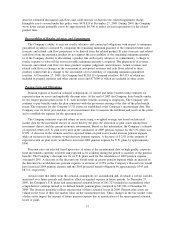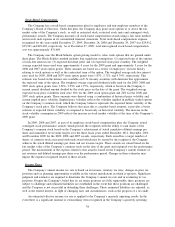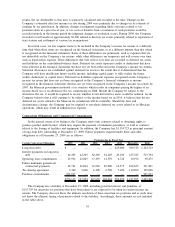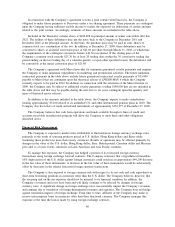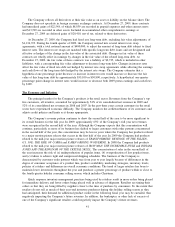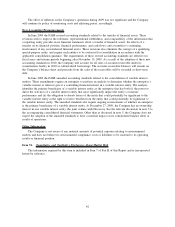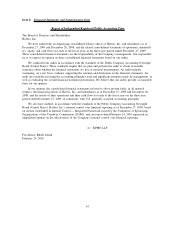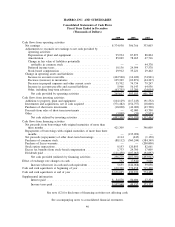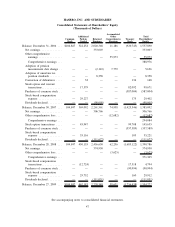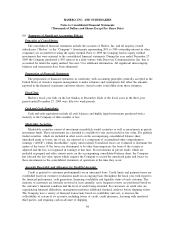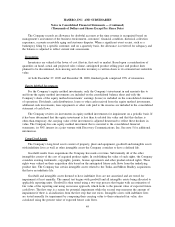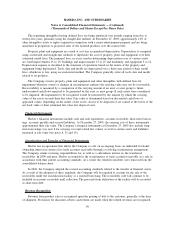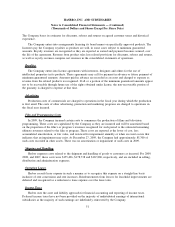Hasbro 2009 Annual Report Download - page 51
Download and view the complete annual report
Please find page 51 of the 2009 Hasbro annual report below. You can navigate through the pages in the report by either clicking on the pages listed below, or by using the keyword search tool below to find specific information within the annual report.
The Company reflects all derivatives at their fair value as an asset or liability on the balance sheet. The
Company does not speculate in foreign currency exchange contracts. At December 27, 2009, these contracts
had unrealized gains of $22,548, of which $8,839 are recorded in prepaid expenses and other current assets
and $13,709 are recorded in other assets. Included in accumulated other comprehensive earnings at
December 27, 2009 are deferred gains of $20,410, net of tax, related to these derivatives.
At December 27, 2009, the Company had fixed rate long-term debt, excluding fair value adjustments, of
$1,134,723. During the fourth quarter of 2009, the Company entered into several interest rate swap
agreements, with a total notional amount of $400,000, to adjust the amount of long-term debt subject to fixed
interest rates. The interest rate swaps are matched with specific long-term debt issues and are designated and
effective as hedges of the change in the fair value of the associated debt. Changes in fair value of these
contracts are wholly offset in earnings by changes in the fair value of the related long-term debt. At
December 27, 2009, the fair value of these contracts was a liability of $2,725, which is included in other
liabilities, with a corresponding fair value adjustment to decrease long-term debt. Changes in interest rates
affect the fair value of fixed rate debt not hedged by interest rate swap agreements while affecting the earnings
and cash flows of the long-term debt hedged by the interest rate swaps. The Company estimates that a
hypothetical one percentage point decrease or increase in interest rates would increase or decrease the fair
value of this long-term debt by approximately $55,100 or $50,800, respectively. A hypothetical one-quarter
percentage point change in interest rates would increase or decrease both 2009 pretax earnings and cash flows
by $189.
The Economy and Inflation
The principal market for the Company’s products is the retail sector. Revenues from the Company’s top
five customers, all retailers, accounted for approximately 54% of its consolidated net revenues in 2009 and
52% of its consolidated net revenues in 2008 and 2007. In the past three years certain customers in the retail
sector have experienced economic difficulty. The Company monitors the creditworthiness of its customers and
adjusts credit policies and limits as it deems appropriate.
The Company’s revenue pattern continues to show the second half of the year to be more significant to
its overall business for the full year. In 2009, approximately 65% of the Company’s full year net revenues
were recognized in the second half of the year. Although the Company expects that this concentration will
continue, particularly as more of its business has shifted to larger customers with order patterns concentrated
in the second half of the year, this concentration may be less in years where the Company has products related
to a major motion picture release that occurs in the first half of the year. In 2009 the Company had products
related to the mid-year major motion picture releases of TRANSFORMERS: REVENGE OF THE FALLEN,
G.I. JOE: THE RISE OF COBRA and X-MEN ORIGINS: WOLVERINE. In 2008 the Company had products
related to the mid-year major motion picture releases of IRON MAN,THE INCREDIBLE HULK and INDIANA
JONES AND THE KINGDOM OF THE CRYSTAL SKULL. The concentration of sales in the second half of
the year increases the risk of (a) underproduction of popular items, (b) overproduction of less popular items,
and (c) failure to achieve tight and compressed shipping schedules. The business of the Company is
characterized by customer order patterns which vary from year to year largely because of differences in the
degree of consumer acceptance of a product line, product availability, marketing strategies, inventory levels,
policies of retailers and differences in overall economic conditions. The trend of larger retailers has been to
maintain lower inventories throughout the year and purchase a greater percentage of product within or close to
the fourth quarter holiday consumer selling season, which includes Christmas.
Quick response inventory management practices being used by retailers result in more orders being placed
for immediate delivery and fewer orders being placed well in advance of shipment. Retailers are timing their
orders so that they are being filled by suppliers closer to the time of purchase by consumers. To the extent that
retailers do not sell as much of their year-end inventory purchases during this holiday selling season as they
had anticipated, their demand for additional product earlier in the following fiscal year may be curtailed, thus
negatively impacting the Company’s future revenues. In addition, the bankruptcy or other lack of success of
one of the Company’s significant retailers could negatively impact the Company’s future revenues.
41



